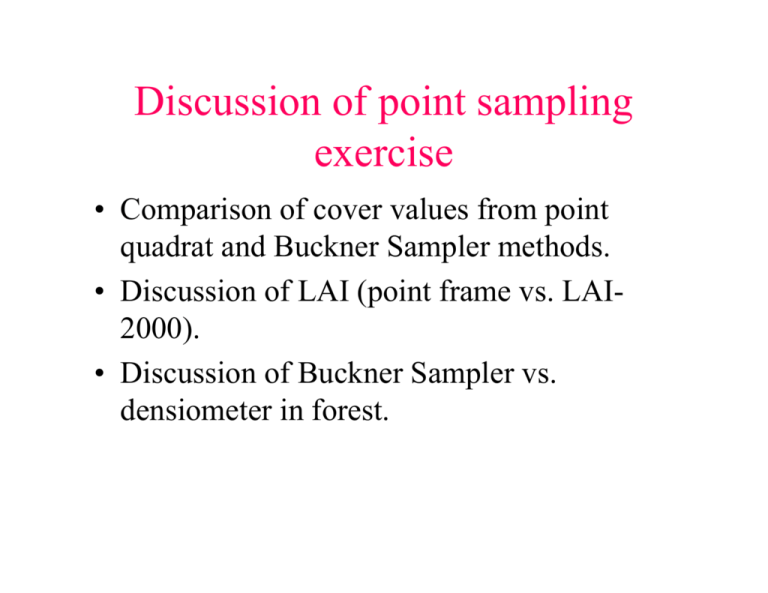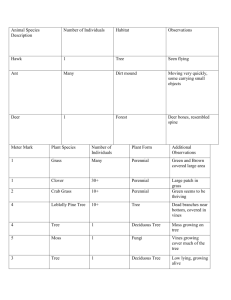Discussion of point sampling exercise
advertisement

Discussion of point sampling exercise • Comparison of cover values from point quadrat and Buckner Sampler methods. • Discussion of LAI (point frame vs. LAI2000). • Discussion of Buckner Sampler vs. densiometer in forest. Lesson 5 Plot-count method and Point-centered-quarter method Review of basic terms • Cover: The area of ground covered by the vertical projection of the aerial parts of plants of one or more species. • Density: The number of plants of a species per unit area (e.g., individuals/m2, or individuals/ha). • Frequency: A measure of the degree of uniformity with which individuals of a species are distributed in an area. The percentage of samples in which at least one individual of the species occurs. • Basal area (= dominance in calculating importance values): The area of the stems of trees per unit area. Count-plot method • Used for determining density and basal area of trees. • Species are counted and measured within a specifically defined area (belt transect or quadrat). • Widely used method for forest inventory. • The main reason for doing a plot as opposed to a plotless methods are: • It can also be used to sample the understory, and thus is useful for vegetation classification • Record a wide variety of other properties, such as soils, site factors, and the plot can be mapped for spatial studies • Useful for long-term studies where the same plot will be revisited in future years. Data obtained in the plot-count method In the United States this is usually done in plots or belt transects (e.g., a 10 x 20-m plot. Sampling often includes: (1) Number of individuals for each tree species above a predetermined minimum diameter. From these data density of each species is determined. (2) Tree diameters at breast height (dbh) using a Biltmore stick or diameter tape and grouped in diameter classes. From these data basal area (cross-sectional area of tree stems at breast height/ha) for each species is determined. (3) Tree heights (e.g., with an clinometer). (4) Trees less than the minimum diameter are classed as seedlings or saplings and grouped into height classes (e.g., 50 cm intervals). Example of plot to determine density and basal area Distance Methods for determining density, frequency and dominance • • • • Developed by Cottam and Curtis in the 1950s to describe the forests of Wisconsin. Density can be determined by first finding the average distance between trees, and then squaring this distance to find the average area occupied per tree. To find the number of trees per unit area, divide the unit area (e.g., a hectare) by the area per tree. Frequency is determined by counting the number of points (sample sites) at which a tree occurs. Dominance is calculated by first determining the mean basal area per tree species and then multiplying by the density of that species. Importance Value IVi = Dri + Fri + Bri IV = importance value i = species i Dri = relative density of species i = (density of species i)/ (density of all species) Fri = relative frequency of species i = (frequency of species i)/ (frequency of all species) Bri = relative dominance of species i = (dominance of species i)/ (dominance of all species) Four distance methods for determining density • • • • Nearest individual - measure distance to the nearest tree at each point (correction factor = 2). Nearest neighbor - the nearest tree is selected and the distance between it and its nearest neighbor is measured. (correction factor = 1.47). Random pairs - a line from a random point to the nearest tree is made and a 90˚ exclusion is erected on either side of the line. The distance to the nearest tree outside the exclusion angle is measured. (Correction factor = 0.8) Pont-centered quarter (PCQ) - a pair of perpendicular lines are erected at the random point, forming a cross with four quadrants. The distances to the nearest tree in each quadrant are measured. This method can also yield a measure of frequency (the number of sample points at which a species occurs). Notes: 1. The distances are calculated separately for each tree species. 2. The squared distances are the areas occupied by each tree. 3. If the average area per tree is divided into a unit of area (e.g. ha), this will give the density of the trees. Distance methods Nearest individual Nearest neighbor Point-centered quarter Random pairs Wandering quarter method (Catana 1953; Bonham 1989) • Plotless method to estimate density. • Based on nonparametric statistical procedure. • Validity not restricted to species following random spatial patterns. • Less sensitive bias when plants exhibit contagious or regular arrangements. • Complicated computational requirements are a disadvantage of the method. Bonham, C.D. 1989. Measurements for terrestrial tegetation. John Wiley & Sons, New York. pp. 169-174. Catana, A.J. 1953. The wandering quarter method of estimating population density. Ecology 44:349-360. Point-centered quarter method • • 20 m 40 m 60 m 80 m 100 m A • B • Sample points Layout random transect (AB) Sample at regular intervals along the transect. At each sample point, lay a meter stick down perpendicular to the transect to define 4 quarters (quadrants). Many shorter transects (rather than a few long ones) are less susceptible to problems related to clumped distribution patterns. Point-centered quarter method (Cont’) • At each sample point (Pt), measure the distance (d) to the nearest tree in QuickTime TIFF (Uncompressed each quadrant. are needed to see • Also measure dbh and record the tree species. Example using 1994 Flagstaff Mountain data • North-facing slope of Flagstaff Mountain, Colorado • Pinus ponderosa - Pseudotsuga menzeisii forest • Sampled using point-centered quarter method Sample data for Point-centered quadrat method from Flagstaff Mtn. Colorado, 1994 Sample point 1 2 3 4 5 6 Quadrant No. 1 2 3 4 1 2 3 4 1 2 3 4 1 2 3 4 1 2 3 4 1 2 3 4 Species code Psemen Psemen Psemen Psemen Psemen Psemen Psemen Psemen Psemen Psemen Psemen Pinpon Psemen Psemen Psemen Psemen Psemen Psemen Psemen Psemen Psemen Pinpon Psemen Psemen Distance (m) 2.1 3.9 2.3 3.1 1.6 4.9 1.4 3.1 1 2.5 4.3 2.1 2.4 0.25 3.3 3.3 2.2 0.71 3.6 4.3 7 5 5.3 6.6 Sum = 76. 3 m Dbh (cm) 2 8 2 20 3 36 22 35 17 16 5 36 8 35 7 2 2 31 3 32 38 18 2 18 Basal Area (cm2) 3 50 3 314 7 1018 380 962 227 201 20 1018 50 962 38 3 3 755 7 84 1075 254 3 227 Conversion of dbh to basal area (1) Ba = Π (dbh/2)2 or (2) Tables of basal areas Table 3. Conversion of dbh to basal area. dbh (cm) 1 2 3 4 5 6 7 8 9 10 11 12 13 14 15 16 17 18 19 20 21 22 23 24 25 BA (cm2) 0.8 3.1 7.1 12.6 19.6 28.3 38.5 50.3 63.6 78.5 95.0 113.1 132.7 153.9 176.7 201.1 227.0 254.5 283.5 314.2 346.4 380.1 415.5 452.4 490.9 dbh (cm) 26 27 28 29 30 31 32 33 34 35 36 37 38 39 40 41 42 43 44 45 46 47 48 49 50 BA (cm2) 530.9 572.6 615.8 660.5 706.9 754.8 804.2 855.3 907.9 962.1 1017.9 1075.2 1134.1 1194.6 1256.6 1320.3 1385.4 1452.2 1520.5 1590.4 1661.9 1734.9 1809.6 1885.7 1963.5 dbh (cm) 51 52 53 54 55 56 57 58 59 60 61 62 63 64 65 66 67 68 69 70 71 72 73 74 75 BA (cm2) 2042.8 2123.7 2206.2 2290.2 2375.8 2463.0 2551.8 2642.1 2734.0 2827.4 2922.5 3019.1 3117.2 3217.0 3318.3 3421.2 3525.7 3631.7 3739.3 3848.5 3959.2 4071.5 4185.4 4300.8 4417.9 dbh (cm) BA (cm2) 76 77 78 79 80 81 82 83 84 85 86 87 88 89 90 91 92 93 94 95 96 97 98 99 100 4536.5 4656.6 4778.4 4901.7 5026.5 5153.0 5281.0 5410.6 5541.8 5674.5 5808.8 5944.7 6082.1 6221.1 6361.7 6503.9 6647.6 6792.9 6939.8 7088.2 7238.2 7389.8 7543.0 7697.7 7854.0 Relative density, frequency, and dominance and importance value • • Relative density of a species is the absolute density of a species in a plot or set of samples divided by the sum of the absolute densities of all species. (Similarly, relative dominance of a species is the absolute dominance of a species divided by the sum of dominances for all species; and relative frequency is the frequency of an individual species divided by the sum of frequences for all species in a plot.) Importance value (I.V.): a measure of the relative importance of a species. It is the sum of the relative density, relative dominance, and relative frequency. The maximum value of I.V. is 300. This is often converted to percentage importance by dividing by 3. I.V.j = Drj + Frj + Brj, where: I.V.j = Importance value of species j, Drj = Relative density of species j, Frj = Relative frequency of species j, Brj = Relative dominance (basal area) of species j. Step 1. Calculation of relative density (Drj) for Flagstaff Mtn. data pm = Pseudotsuga menziesii, pp = Pinus ponderosa Drj = nj/N x 100%, where nj = number of trees of species j, and N = Total number of trees. Drpm = 22/24 x 100% = 91.7% Drpp = 2/24 x 100% = 8.3%. Step 2. Calculation of absolute density (Da) Da = unit area (e.g. ha)/ A, where Da is the total number of trees per unit area, and A = average area occupied by a tree. di = distance from sample point to individual tree i. dt = total of all distance measurements (column 4 in sample data table). d = average distance between trees. N = total number of trees. N dt = d = 76.3 m Σ i=1 i d = dt /N = 76.3/24 = 3.2 m/tree A = d2 = (3.2)2/tree = 10.1 m2/tree Da = 1 ha/10.1 m2/tree = (104 m2/ha)/(10.1 m2/tree) = 990 trees/ha Denstiy of each tree species: Daj = Drj x Da, where Daj is the absolute density of species j. Drj is relative density of species j (from Step 1). Dapm = .917 x 990 = 908 trees/ha Dapp = 0.83 x 990 = 82 trees/ha Step 3. Calculation of absolute frequency (Fa) Faj = mj/m, where j is the total number of sample points where species j occurs, and m is the total number of sample points. Fapm = mpm/m = 6/6 = 1.00 Fapp = mpp/m = 2/6 = 0.33 Step 4. Relative frequency (Fr) k Fa ) x 100%, where k is the total number of species. Σ i=1 Frj = Faj/ ( i Frpm = 1.00/1.33 x 100% = 75.2% Frpp = 0.33/1.33 x 100% = 24.8% Step 5. Calculation of absolute dominance (Ba) Baj = Baj x Daj, where is Baj the absolute dominance of species j. Baj is the average basal area for species j, and Daj is the absolute density of species j. Bapm = Bapm x Da = (7112 cm2/(22 trees)) x 990 trees/ha (7112 is the sum of basal areas for Pseudotsuga menziesii, 22 is the number of sampled PSEMEN) = 293,284 cm2/ha = 29.3 m2/ha Bapm = (1272 cm2 / (2 trees)) x 82 trees/ha = 52,152 cm2/ha = 5.2 m2 ha Step 6. Calculation of relative dominance (Br) k Ba ) x 100%, where k is the total number of species. Σ i=1 Brj = Baj/ ( i Brpm = 29.3/(29.3 + 5.2) x 100% = 29.3/ 34.5 = 85.6% Brpp = 5.2/34.5 x 100% = 14.4% Step 7. Calculation of importance value (I.V.) I.V.j = Drj + Frj + Brj I.V.pm = 75.2% + 91.7% + 85.6% = 252.5% I.V.pp = 24.8% + 8.3% +14.4% = 47.5% Step 8. Calculation of relative importance value (IVr) k Σ i=1 IVrj = IVj/ ( IVi) x 100%, where k is the total number of species. IVrpm = (252.5/300) x 100% = 84.2% Brpp = (47.5/300) x 100% = 15.8% Bitterlich Stick and prism method for determining basal area With this stick, the number of trees counted is equal to the basal area in m2 ha-1. Armed with this bit of knowledge the Biol 475 teams are ready to attack any forest! Chris QuickTime™ and a TIFF (Uncompressed) decompressor are needed to see this picture. Troy Corinne Lab 5: Forest sampling methods • • • • Plot count method Point-centered quarter method Measure tree heights (clinometer) Tree-coring








